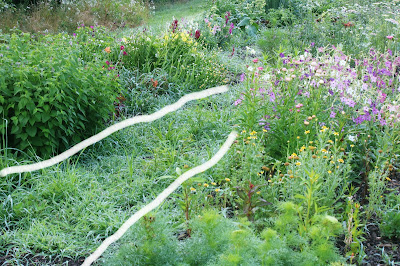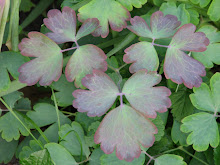We're in "the end is near!" summer...just five weeks until September! No rain, high humidity, and melting temperatures...pretty much August in Indiana. Somehow new flowers are popping, like this hydrangea that I planted a couple of years ago and then forgot about:
The weather (and my apathetic watering) is pushing many flowers into seed. I'm trying something new this year: drying flowers for fall wreaths. I've got my first batch hanging in the attic now!
I've got a fairly casual and even indifferent attitude toward this year's garden. I know that I took on too much, cultivated too much land, and made a fatal mistake when I assumed that weeds germinating in the pathways would die. There was only a tiny bit of decomposed mulch over the landscape fabric, and I figured that the weed roots would hit the fabric and wither away. Well...not so much. The white-marked places are the paths. The weeds flourished and worse, spread quickly into my flower beds.
Last week I saw my first zebra swallowtail butterfly, and this week, my first giant swallowtail! At first glance, it looks exactly like an eastern swallowtail:
eastern swallowtail
giant swallowtail
But if you look at their abdomens, you'll see that the eastern swallowtail is striped, while the giant swallowtail is plain. In the top picture, too, you'll see that the eastern swallowtail yellow and black coloration is shown identically on the back of its wings. But the giant swallowtail has an arresting pattern of deep black with bold yellow slashes.
Love!!
Last week, Todd pulled his old car around and temporarily parked it in our side driveway. We were working at the kitchen table together when I noticed a darting shape by his front tire. A groundhog!
(Photos taken through glass, so not quite clear!)
When dusk deepened, he crept out to feed.
Groundhogs can cause a terrible amount of damage in a car. They love to chew on wires! We let him have his sleep the next day, but that evening, we opened the hood. Sure enough, a thick section of insulation had been scratched out, but wires seemed intact, and the groundhog was long gone. Todd promptly moved the car to a safer spot!
We went geocaching this week...
...and saw something odd. It's the time of year for a large concentration of harvestmen, or what most people call granddaddy long-legs. They aren't true spiders, as they don't produce venom, spin webs, or have segmented bodies. This year, it seems like almost every one that I see has tiny red specks on their long, segmented legs.
They're a type of red mite that feeds on the harvestman and then drops off. Scientists aren't sure, but it seems to be a parasitic relationship (with the mites removing liquid from the legs), and the effect on the harvestman is unknown (but seems...minimal?).
Harvestmen like to clump together and I saw something amazing this past week: a mating pair! I didn't have the right macro lens (aaarrrgghhh!), but my wider lens clumsily captured the action.
So interesting!
More discoveries on our geocache hike: a ton of fungus! Here's what I think is an indigo milky cap mushroom, potentially edible but definitely gorgeous.
It's hugely popular in Chinese medicine. It's a popular soup-thickener and also used to make both desserts and cosmetics!
Yet another edible spotted is this white-tipped coral mushroom.
For us, it's a general rule to identify mushrooms but leave them alone, even the ones that we think are edible. Better safe than sorry!
It's nice to take these little walks in the early morning, before the heat of the day comes on. Just another month before we can get back to hiking in earnest.
Have a great week!
































































